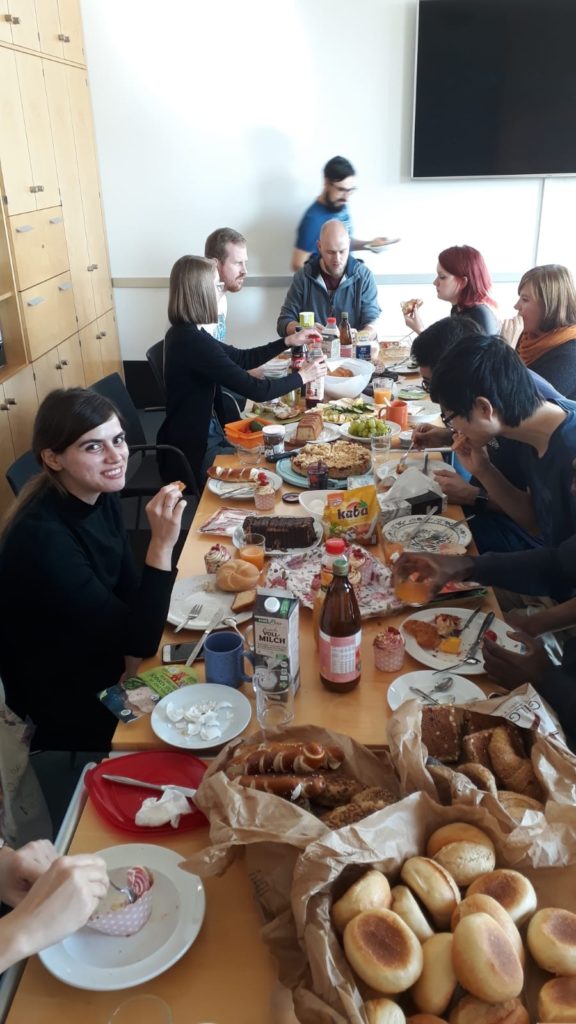When people think “Germans,” I’m not exactly sure what they think – perhaps they’re picturing bread and Leberwurst, World War II scenes, or imagining the sound of the German language. Whatever they’re hearing or picturing, I don’t think they usually think “social!” right away; but based on my experience thus far, they perhaps should.
During this last month in Germany, I have experienced many new things – Black Forest cake, copious quantities of Brötchen and bureaucracy, the sight of Lederhosen and Dirndls in every direction – and I have been privileged to take part in a number of German activities – or at least, activities with other Germans. And one thing I have distinctly noticed is how highly Germans value social activities and community. Certainly, I think most societies value community. Americans, in particular, I think often like to think of ourselves as a social people. Perhaps that’s not untrue, but in an admittedly broad generalization, I think Germans value community perhaps more, and in slightly different ways.
One friend of mine – a fellow Fulbrighter here – suggested that perhaps Americans are social, but Germans are a more communal people. I certainly think this thought has some value. Based on my own ideas, and my interpretations of the dictionary definitions, while the word social suggests ideas of companionship and grouping together, the word communal suggests a greater emphasis on inclusivity.
As a new person in Germany, I have most definitely enjoyed the inclusive aspect of many German people and activities. My roommates, for example, have invited me to group sports games, dental medicine parties, and more. Now, you might be thinking, “She just has fantastic roommates,” and to that I would certainly agree. But I also think inclusivity is built into the social infrastructure here. University sports here are open to all – as long as you sign up via the website, which everyone has access to at the same time – regardless of experience. You’ve never heard of Spiel and Spaß before but want to join? Absolutely! You haven’t danced before, but would like to learn? Com and join! Don’t have a partner? Use our partner finder! (Side note: this last example is real – I did that – so stay tuned!) Compare that to sixth grade Marta, who wanted to join a soccer team, and was told it was too late, since she needed to start at approximately age 4 in order to have any chance of being able to play in the major leagues that are middle school American soccer.

Outside of organized events like sports, German daily life also tends to prioritize social and communal events. German grade-school students have much more flexible schedules (more similar to U.S. college student schedules) than most U.S. high school students, and frequently have time to go home and enjoy a leisurely lunch with family and/or friends. My experience of high school lunch often involved spending half of the 30-minute lunch break in line for cafeteria food or the microwave, leaving little time for relaxed eating or socializing. The German tradition of afternoon Kaffee and Kuchen, where people take a break in the afternoon and catch up with a friend or relative over a cappuccino and slice of cake, also encourages social communion. While some say the tradition is waning, I still frequently observe it taking place in cafes around the city. Further, while certainly not unseen, I think it is much less common here to see coffee shops full of people each sitting at their own tables, earbuds in, laptops out, than it is in the U.S. In support of this, just last week my friend and I were at a cafe, and as things got busier two women, one older, one about my age, asked if the empty seats at our table were free (this is not uncommon in Germany). After a few minutes of keeping to our separate groups, we got into conversation. As it turns out the older woman was a retired tropical medicine specialist who had lived in a number of different places – Tanzania is the only one I can specifically recall, but I know she lived in several different parts of Africa – before coming to Bonn to take a government position advising on health policy. Her friend, the younger woman, was an international student from China studying cultural anthropology at the University of Bonn. (As another illustration of the spontaneous social interactions Germany offers, these two women apparently became friends when they met after both buying currywurst from the same little stand!). With my friend Shirin is doing a Fulbright project related to both neuroscience and anthropology, and my own interests in history, anthropology, and medicine, we had plenty of common interests to discuss! The conversation as a whole was a fun mixture of English and German – and a fun chance for Shirin and I to practice our German – as the older woman spoke English (and German, of course), but the younger Chinese student spoke Chinese and German, and very little English. After some conversations about the challenges of medicine and the connections between medicine, and anthropology, we got to discussing German cakes, and before long the older woman had offered to buy Shirin and I each another slice of cake – a gooseberry meringue one that she thought we should try! After some further discussions about books, complete with additions to each of our “to-read” lists, we exchanged email addresses and said good-bye. Would this happen in the U.S.? Perhaps, but I think the sociocultural atmosphere of Germany greatly increases the chances of such spontaneous social events.
In the lab where I work I have also noticed a distinct emphasis on socialization. Research labs tend to be known for their studious workers, and thus are not always the most socially stimulating of places. In many of the labs where I have interned in the U.S., students collaborate, of course, and socialize here and there, but they often eat lunch alone, and organized lab events not directly related to the research are infrequent. In my lab here, where I have worked for just two weeks so far, I have already taken part in an excellent lab brunch, been invited to join the daily cafeteria lunch group and the daily bring-your-own-lunch group, heard about an upcoming planned international lunch, and taken part in discussions about social events for the evening, outside of work. Certainly, the social environment depends very much on which lab one is in, how the PI, leads, etc. At my lab at the Buck Institute in California, for example, we went on a great lab hike together, and occasionally had group lab lunches. Further, my lab here in Bonn very well could be different from the average German lab – perhaps exceptionally welcoming and social. Based on my limited experience in a German research institution so far, however, both in observing my own lab and others in the building, it appears to me that socialization within the lab group – outside of strictly research-related matters – is perhaps both more frequent and more valued than in your average American lab.
On the home front, my housemates have been extraordinarily inclusive, inviting me to join their friends at parties, games, and meal-making. Now, they know I am an American with few connections here, and perhaps they are just being kind. I would argue, however, that this is a sharp contrast to the frequent cliquishness of many student/university/young adult environments in the U.S. As one brief illustration of my argument, before I even arrived in Germany, my WG added me to their group chat. In comparison, I think entrance to group chats is often considered more of a privilege than a right in the U.S., something bestowed on those when they have proved they are worthy. Specifically, I recall in my first year of college being desperately stressed when I realized some people I knew where planning caf meet-ups and other plans in a group chat I was not a part of, and trying to think of a way to non-awkwardly ask to be made a part of the chat. Perhaps a silly example, but my German housemates entirely removed the possibility of any potential awkwardness or stress on my part – they simply included me. In daily house life, too, they do more together than I think is common in your average American shared students’ apartment. We plan WG-nights (WG is short for Wohngemeinschaft, and usually refers to a shared apartment), cook together, play games, watch movies, sing, and chat. Now, of course, there are a few caveats I would be remiss to omit. First of all, I did many of these things in my time as a college student in the U.S., too – especially when I lived with the fantastic Oslo 2 group at Luther last year. I also don’t know how representative my shared apartment is of the “average” student/young adult experience here in Germany. Thus far, however, I have sensed a greater emphasis on cultivating a warm and familial atmosphere in the WG than I think is necessarily common in shared student homes in the U.S.
These are, of course, personal opinions and observations, and some are generalizations, but maybe we Americans have a little something to learn from Germany. Perhaps we could incorporate some of what I have observed as German culture’s greater emphasis on inclusivity over competition, learn from Germany’s allowance for a bit more free/flexible time (which is often used to spend time with others), or simply focus a little more on prioritizing time spent in community.

Leave a Reply